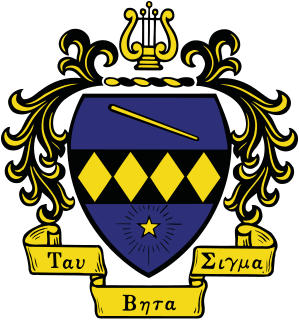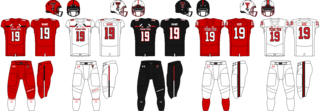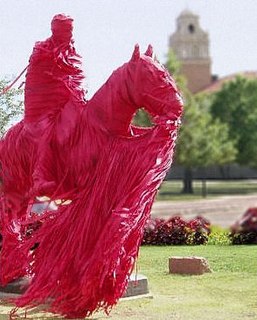
Texas Tech University is a public research university in Lubbock, Texas. Established on February 10, 1923, and called Texas Technological College until 1969, it is the main institution of the five-institution Texas Tech University System. The university's student enrollment is the seventh-largest in Texas as of the Fall 2018 semester. As of fall 2020, there were 40,322 students enrolled at Texas Tech. With over 25% of its undergraduate student population identifying as Hispanic, Texas Tech University is a designated Hispanic-serving institution (HSI).
William Curry Holden was a historian and archaeologist. In 1937, he became the first director of the Museum of Texas Tech University in Lubbock, Texas.

Angelo State University is a public university in San Angelo, Texas. It was founded in 1928 as San Angelo College. It gained university status and awarded its first baccalaureate degrees in 1967 and graduate degrees in 1969, the same year it took on its current name. It offers 50 undergraduate programs and 31 graduate programs. It is the second-largest campus in the Texas Tech University System.

Tau Beta Sigma Honorary Band Sorority, is a co-educational service sorority.

The Daily Toreador, also known as The DT, is the student newspaper of Texas Tech University in Lubbock, Texas. The newspaper was first published in 1925 as The Toreador and later changed its name to The University Daily before arriving at the current name in 2005. All content for The DT is produced by a staff around 40 members including editors, reporters and photographers. The DT has received numerous regional and national awards, including two Columbia Scholastic Press Association Silver crown awards and two Associated Collegiate Press Pacemaker Award finalists. As well, the paper counts five Pulitzer Prizes and four winners amongst its former staff members.

Omega Delta Phi Fraternity Inc. (ΩΔΦ), also known as O-D-Phi is a multicultural fraternity that was founded on November 25, 1987, at Texas Tech University in Lubbock, Texas. Its seven founders known as the "Men of Vision" to fraternity members wanted to create an organization to help students graduate. This initial organization became Omega Delta Phi Fraternity. Over the past thirty years the Fraternity has changed and adopted other values such as an emphasis on Community Service. Omega Delta Phi was named Fraternity of the Year for 2003, 2004, and 2005 by the National Association of Latino Fraternal Organizations (NALFO). Although one of the Greek organizations that founded NALFO, Omega Delta Phi withdrew their membership in December 2008.

The Texas Tech Red Raiders and Lady Raiders are the athletic teams that represent Texas Tech University, located in Lubbock, Texas. The women's basketball team uses the name Lady Raiders, while the school's other women's teams use the "Red Raiders" name.
The Rawls College of Business is the business school of Texas Tech University in Lubbock, Texas. Rawls Business offers curriculum for both undergraduate and graduate students and received its initial business accreditation in 1958 from the Association to Advance Collegiate Schools of Business (AACSB). Established in 1942, Texas Tech's business school was originally known as the Division of Commerce. In 1956, the school was renamed the College of Business Administration. Following a $25 million gift from alumnus Jerry S. Rawls in 2000, the school was renamed as Jerry S. Rawls College of Business Administration.

The Texas Tech Red Raiders football program is a college football team that represents Texas Tech University. The team competes as a member of the Big 12 Conference, which is a Division I Football Bowl Subdivision of the National Collegiate Athletic Association (NCAA). The program began in 1925 and has an overall winning record, including a total of 11 conference titles and one division title. On November 8, 2021, Joey McGuire was hired as the team's 17th head football coach, replacing Matt Wells, who was fired in the middle of the 2021 season. Home games are played at Cody Campbell Field in Lubbock, Texas.

The Double T is a logo that is the most readily identified symbol of Texas Tech University.

Texas Tech University traditions are an important part of the culture of Texas Tech University.

The history of Texas Tech University dates back to the early 1880s, but the university was not established until 1923.

The Administration Building is a structure on the campus of Texas Tech University in Lubbock, Texas. It was one of the original buildings on the campus, and is modeled after the Universidad de Alcala de Henares in Alcalá de Henares, Spain. The Admin building has three floors and a basement and includes twin bell towers, double wings, and a courtyard. Some of the offices housed in the building include the Chancellor's Office, President's Office and Board of Regents Office.

Texas Tech University, often referred to as Texas Tech or TTU, is a public, coeducational, research university in Lubbock, Texas, United States. Texas Tech offers 150 bachelor's, 104 master's, and 59 doctoral degree programs through 11 academic colleges, a graduate school and a school of law.

Wendy Lee Motlong Masiello retired as a lieutenant general in the United States Air Force on May 24, 2017. From May 2014 to May 24, 2017, she was the director of the Defense Contract Management Agency, based in Fort Lee, Virginia.
Elmer Lois Tarbox was an American military aviator, businessman, and politician. Tarbox served as a member of the Texas House of Representatives from 1967–1977.

West Hall is a building on the campus of Texas Tech University in Lubbock, Texas. It was designed by noted American architect Wyatt C. Hedrick. Originally designated “Men’s Dormitory #1”, the building was subsequently renamed West Hall after James Marion West Sr., a Texas businessman and philanthropist who was a member of the university's board.














